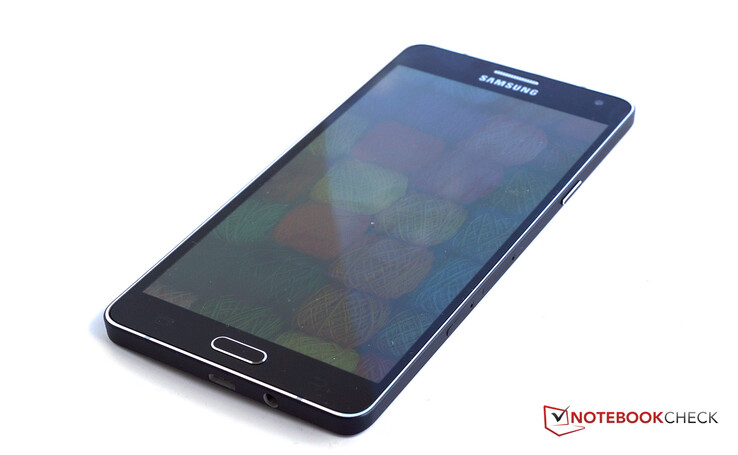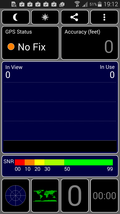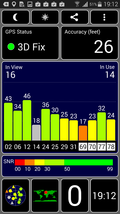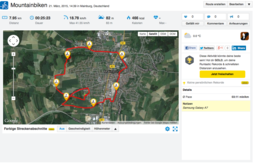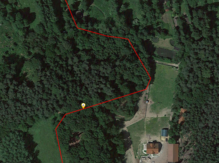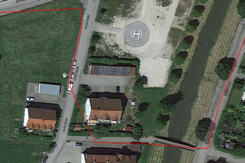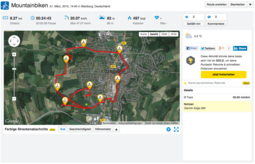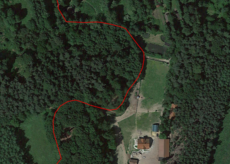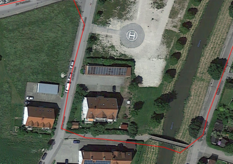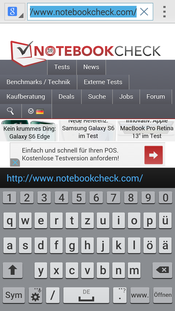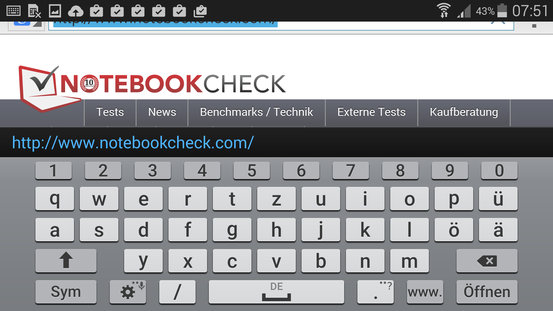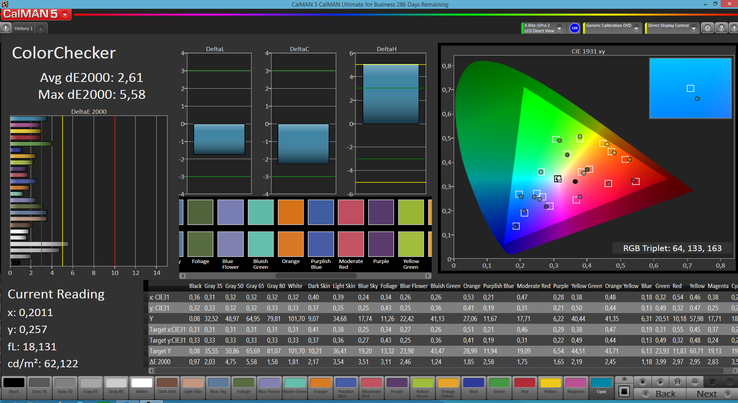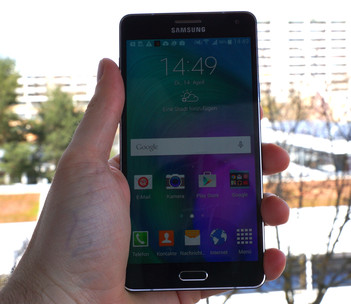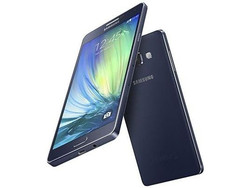Samsung Galaxy A7 Smartphone Review
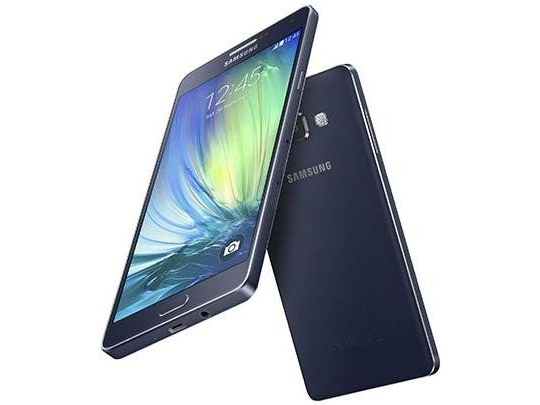
For the original German review, see here.
The Galaxy A lineup has convinced many buyers with its unibody casings, and its plain yet very elegant design. However, it also slapped Galaxy purists with things like the non-removable battery. Nevertheless, the smaller Galaxy A3 and Galaxy A5 also did well in our tests. Now an even bigger device from the lineup is coming to the market: the Galaxy A7 that can be called a phablet with a size of 5.5 inches.
The buyer will again find the metal unibody casing, high-quality camera, and slim design. The device is tagged with a recommended price of 499 Euros (~$539), just like HTC's Desire Eye, Huawei's Ascend Mate 7, Sony's Xperia Z3 Compact or Motorola's Moto X. Google's Nexus 6 is more expensive, but Nokia's Lumia 930 premium-range Windows Phone is considerably less pricey in some shops.
Case
One of the Galaxy A lineup's identifying features is the metal unibody casing. Although the back suggests high-quality plastic, it is metal, namely magnesium. The bezel is aluminum and contributes to the casing's stiffness. However, the casing's slim build with a height of just 6.3 millimeters (~0.25 inches) involves waiving features like the removable back cover or exchangeable battery, which used to be sure signs that the user was holding a Galaxy smartphone in his hands.
The rigidness of the biggest device (so far) of the Galaxy A lineup is also impressive. Pressure has absolutely no effect on the casing, and very strong pressure has to be applied before triggering a noise. The micro-SD card and nano-SIM are inserted in removable trays on the sides.
The rear-facing camera clearly juts out, and it could thus be susceptible to scratches. Furthermore, it causes the smartphone to teeter back and forth during use on a table. The front features Samsung’s familiar "Home" hardware button and two touch buttons for back and an overview of recently opened apps.
Connectivity
Our Samsung Galaxy A7 only has one SIM slot, but models with dual-SIM support are also available. The Galaxy A7 is neither good nor bad with its storage capacity of 16 GB. The working memory of 2 GB is also standard in this category now.
Software
Samsung's TouchWiz UI in the Galaxy A7 is also based on Android 4.4.4. However, an update to Android 5 for the Galaxy A lineup is in the works according to media reports. Samsung's user interface has become very smooth in use, which was not always the case. Android veterans will notice a few modifications compared with vanilla Android, but its use is largely very similar. Newcomers will also quickly become familiar especially since there is an "Easy mode" where only a minimum is displayed on the home screen.
At the same time, TouchWiz is very rich in features: there is "Safety Assistance" that minimizes power consumption and sends emergency messages, images and audio information to important contacts. Besides that, a blocking mode for defining "do not disturb" times, there are dozens of input aids for the physically impaired, a multi-window mode that enables opening specified applications in a window, and which leaves part of the home screen visible.
Samsung additionally preloads some software, such as the nicely designed "S Planner" calendar app, or "S Voice" voice control. However, the user will also have to live with adware.
Communication & GPS
Mobile telecommunication networks are just as accessible with the Galaxy A7 as with the smaller Galaxy A5: the quad-band GSM and UMTS net as well as five LTE frequencies are available. This configuration is satisfactory, but Sony's Xperia Z3 Compact and Huawei's Ascend Mate 7, for example clearly outshine that. Our review sample's signal quality was impeccable in an urban area using the rather poorly developed German E-Plus net. We consistently had the full LTE reception even indoors making speeds of up to 150 MBps down and 50 MBps up possible.
NFC for near field communication is also installed, and Wi-Fi standard 802.11 a/b/g/n is also incorporated. Thus, the 5 GHz band is supported but the even faster ac standard is not available. Some comparison devices also have a wider bandwidth here. Wi-Fi reception was below average: Only a quarter of the signal was displayed at a distance of ten meters (~33 feet) and through three walls, and websites opened considerably slower.
The GPS module also supports the Russian GLONASS system, but it could only locate us roughly when standing close to a window indoors. However, it instantaneously linked to a satellite outdoors; it was then stable and tracked us with an accuracy of 7 meters (~23 feet).
Compared with the Garmin Edge 500 navigation system, our review sample measured approximately 250 meters (~273 yards) less on our bike route. That is not surprising because the GPS tends to take shortcuts and lets us "fly" over houses or trees rather than staying on the street. Although this behavior was not consistently observed, it happens.
Telephone & Voice Quality
The voice quality of the smaller Galaxy A models did not really convince us. The microphones were rather mediocre, and the speaker's quality did not knock our socks off, either. That looks pretty much the same in the Galaxy A7. Our review sample's speaker had problems primarily with sibilants like "s" or "z" so that our contact sounded like he lisps. Furthermore, our contact complained that our voice was accompanied by static noise.
Everyone who has ever used a Samsung smartphone will recognize the phone app, but it will not puzzle Android-mavens much, either. Newcomers should also soon be familiar with the app, which is divided in four categories: "Keypad", "Logs", "Favorites", and "Contacts". Beyond that, contacts can be selected for speed dial, extensive information about previous communication with a caller can be displayed, and there are multiple options for accepting or declining calls.
Cameras & Multimedia
The camera configuration corresponds with that of the smaller Galaxy A5. A 13-megapixel camera with LED flash and auto-focus is on the rear, and a 5-megapixel lens for shooting decent selfies is on the front. These specs place the Galaxy A7 on category standard, but higher-quality camera configurations are also available in this price range, for example in Nokia's Lumia 930 or HTC's Desire Eye.
The colors of the rear-facing camera are again good although the pictures are not quite as sharp as, for example, from the iPhone 6. The "main camera selfie" mode enables taking selfies without the viewfinder; the camera automatically focuses on the face. That functions quite well even if the sharpness is not always 100% accurate, and you see only in hindsight if your finger was covering the lens. However, the pictures exhibit visible pixels especially in slightly lower light.
The 5-megapixel front-facing camera also takes decent pictures, but the images look quite grainy in total.
Accessories
The Galaxy A7 is shipped with a headset. Otherwise, the box contains the standards in form of a charger and USB cable. A protective silicon cover that protects the smartphone against shocks (20 Euros/~$22) or an S View cover with window (40 Euro/~$43) is available in Samsung's shop.
Warranty
Samsung includes a 24-month warranty on the smartphone. Expendable parts, such as the battery, are only covered for six months.
Input Devices & Handling
We liked Samsung's on-screen keyboard for its lack of bells and whistles, and the unambiguous lettering without confusing double-assignment. The keys look a bit small on the Galaxy A7's 5.5-inch screen at first, but they can be used accurately owing to their larger spacing.
Inputting via handwriting, voice dictation, swiping to enter words, swiftly changing the input language and word suggestions is possible. Beyond that, there are multiple setting options and a number row above the letters. Generally, a very good on-screen keyboard.
The touchscreen is sensitive up to its corners, and it responded quickly and reliably to our inputs. There is also a glove mode that enables using the smartphone with thin gloves in the winter.
Display
Samsung initially issued a press release that the Galaxy A7 would only be equipped with a 720p screen. However, it would have lagged far behind comparable smartphones with that. In any case, Samsung announced that it was a mistake shortly afterward, and our reviewed 5.5-inch Galaxy A7 has a Full HD screen.
The screen is again based on the Super AMOLED technology, and thus Samsung uses organic light-emitting diodes that light up autonomously, but they were not very bright in the past. The Galaxy A7's average brightness of 337.3 cd/m² is satisfactory. Comparable smartphones have significantly brighter screens, and even the smaller Galaxy A5 has more to offer here. The illumination of our review sample is very good with a homogeneity of 91%, and brightness differences in large areas are not visible.
| |||||||||||||||||||||||||
Brightness Distribution: 91 %
Center on Battery: 338 cd/m²
ΔE ColorChecker Calman: 2.28 | ∀{0.5-29.43 Ø4.79}
ΔE Greyscale Calman: 2.24 | ∀{0.09-98 Ø5}
Gamma: 2.47
CCT: 6367 K
| Samsung Galaxy A7 Adreno 405, 615 MSM8939, 16 GB eMMC Flash | Samsung Galaxy A5 Adreno 306, 410 MSM8916, 16 GB eMMC Flash | Google Nexus 6 Adreno 420, 805 APQ8084, 32 GB eMMC Flash | HTC Desire EYE Adreno 330, 801 MSM8974AB, 16 GB eMMC Flash | Motorola Moto X 2. Gen 2014 Adreno 330, 801 MSM8974AC, 16 GB eMMC Flash | Sony Xperia Z3 Compact Adreno 330, 801 MSM8974AC, 16 GB eMMC Flash | Huawei Ascend Mate 7 Mali-T628 MP6, Kirin 925, 16 GB eMMC Flash | Nokia Lumia 930 Adreno 330, 800 MSM8974, 32 GB eMMC Flash | |
|---|---|---|---|---|---|---|---|---|
| Screen | 18% | -66% | 1% | -53% | -103% | 6% | -138% | |
| Brightness middle (cd/m²) | 338 | 482 43% | 274 -19% | 635 88% | 259 -23% | 513 52% | 451 33% | 275 -19% |
| Brightness (cd/m²) | 337 | 432 28% | 264 -22% | 631 87% | 263 -22% | 500 48% | 455 35% | 278 -18% |
| Brightness Distribution (%) | 91 | 85 -7% | 89 -2% | 92 1% | 91 0% | 94 3% | 93 2% | 89 -2% |
| Black Level * (cd/m²) | 0.54 | 0.41 | 0.46 | |||||
| Colorchecker dE 2000 * | 2.28 | 2.15 6% | 6.99 -207% | 4.11 -80% | 6.52 -186% | 8.54 -275% | 2.49 -9% | 10.99 -382% |
| Greyscale dE 2000 * | 2.24 | 1.81 19% | 4.01 -79% | 4.29 -92% | 3.05 -36% | 9.88 -341% | 2.88 -29% | 8.29 -270% |
| Gamma | 2.47 89% | 2.42 91% | 2.03 108% | 2.59 85% | 2.31 95% | 3.03 73% | 2.16 102% | |
| CCT | 6367 102% | 6626 98% | 6329 103% | 6956 93% | 6226 104% | 8659 75% | 6731 97% | |
| Contrast (:1) | 1176 | 1251 | 980 |
* ... smaller is better
Perhaps the biggest advantage of OLEDs is that they can be turned off completely and do not emit any light whatsoever. Consequently black is really deep, dark, and rich. That results in an infinitely high contrast ratio with saturated and brilliant colors.
The Galaxy A7 offers different screen modes that can be changed in the settings. They are called "Standard", "Photo" and "Cinema", and it is possible to set the mode to automatic when preferred. The differences are very evident: "Standard" is the most restrained mode, but also the one with the most natural color hues in pictures. The colors look somewhat brighter in "Photo" and makes pictures look more dynamic, but not quite as natural. Finally, "Cinema" reproduces the most intense colors but the high saturation gives the content a light comic-like look.
Our tests, based on the spectrophotometer and CalMAN software, back our subjective impressions. Colors are most natural in "Standard" and oversaturated in "Cinema". The screen only shifts very slightly from the sRGB reference color space in "Standard" mode.
The high contrast generally makes it possible to see something on the screen even in bright surroundings. However, that quickly changes when sunlight shines directly on the display. Besides that, reflections in the screen strain the eyes. Nevertheless, the user will be able to work well with the Galaxy A7 in slightly shadier environments.
Performance
The SoC in the Galaxy A7 is dubbed Qualcomm Snapdragon 615 MSM8939 and has eight processor cores that all clock with 1.7 GHz. However, octa-core SoCs frequently suffer under the lack of support in apps, and thus the full power of the eight cores often cannot be fully utilized. Thus, the Galaxy A7 also delivers quite varying scores in the benchmarks; it sometimes surpasses its rivals and it sometimes clearly lags behind them.
We never experienced speed issues with any of the apps we tested in practice, and the operating system ran smoothly throughout.
| AnTuTu v5 - Total Score (sort by value) | |
| Samsung Galaxy A7 | |
| Samsung Galaxy A5 | |
| Google Nexus 6 | |
| HTC Desire EYE | |
| Motorola Moto X 2. Gen 2014 | |
| Sony Xperia Z3 Compact | |
| Huawei Ascend Mate 7 | |
The Galaxy A7 was generally quite fast in Internet browsing. We achieved good results both in the browser benchmarks as well as in real life.
| Sunspider - 1.0 Total Score (sort by value) | |
| Samsung Galaxy A7 | |
| Samsung Galaxy A5 | |
| Google Nexus 6 | |
| HTC Desire EYE | |
| Motorola Moto X 2. Gen 2014 | |
| Sony Xperia Z3 Compact | |
| Huawei Ascend Mate 7 | |
| Nokia Lumia 930 | |
| Google V8 Ver. 7 - Google V8 Ver. 7 Score (sort by value) | |
| Samsung Galaxy A7 | |
| Samsung Galaxy A5 | |
| Google Nexus 6 | |
| HTC Desire EYE | |
| Motorola Moto X 2. Gen 2014 | |
| Sony Xperia Z3 Compact | |
| Octane V2 - Total Score (sort by value) | |
| Samsung Galaxy A7 | |
| Samsung Galaxy A5 | |
| Google Nexus 6 | |
| HTC Desire EYE | |
| Motorola Moto X 2. Gen 2014 | |
| Sony Xperia Z3 Compact | |
| Huawei Ascend Mate 7 | |
| Nokia Lumia 930 | |
| Mozilla Kraken 1.1 - Total (sort by value) | |
| Samsung Galaxy A7 | |
| Samsung Galaxy A5 | |
| Google Nexus 6 | |
| HTC Desire EYE | |
| Motorola Moto X 2. Gen 2014 | |
| Sony Xperia Z3 Compact | |
| Huawei Ascend Mate 7 | |
| Nokia Lumia 930 | |
* ... smaller is better
The Adreno 405 is a mid-range graphics unit that is clearly defeated by, for example, the Adreno 420 in Google's Nexus 6 in our benchmarks. However, it should still be strong enough for current games.
| GFXBench (DX / GLBenchmark) 2.7 | |
| T-Rex Onscreen (sort by value) | |
| Samsung Galaxy A7 | |
| Samsung Galaxy A5 | |
| Google Nexus 6 | |
| HTC Desire EYE | |
| Motorola Moto X 2. Gen 2014 | |
| Sony Xperia Z3 Compact | |
| Nokia Lumia 930 | |
| 1920x1080 T-Rex Offscreen (sort by value) | |
| Samsung Galaxy A7 | |
| Samsung Galaxy A5 | |
| Google Nexus 6 | |
| HTC Desire EYE | |
| Motorola Moto X 2. Gen 2014 | |
| Sony Xperia Z3 Compact | |
| Nokia Lumia 930 | |
| GFXBench 3.0 | |
| on screen Manhattan Onscreen OGL (sort by value) | |
| Samsung Galaxy A7 | |
| Samsung Galaxy A5 | |
| Google Nexus 6 | |
| HTC Desire EYE | |
| Motorola Moto X 2. Gen 2014 | |
| Sony Xperia Z3 Compact | |
| Huawei Ascend Mate 7 | |
| 1920x1080 1080p Manhattan Offscreen (sort by value) | |
| Samsung Galaxy A7 | |
| Samsung Galaxy A5 | |
| Google Nexus 6 | |
| HTC Desire EYE | |
| Motorola Moto X 2. Gen 2014 | |
| Sony Xperia Z3 Compact | |
| Huawei Ascend Mate 7 | |
On the other hand, the speed of the storage in the Galaxy A7 is exemplary: It outperforms all comparison devices here. Too bad that only 16 GB of the swift storage is installed.
Games
The Adreno 405 does its job quite well in terms of games considering it is only a mid-range graphics card. Even in rather demanding tracks like Asphalt 8 we only noticed stutters in the intro sequence to the race but not in the game itself. Stronger graphics units are likely more future-proof, but the Adreno 405 allows playing all games that we presently use for testing without lags.
Emissions
Temperature
The surface temperatures of the Galaxy A7 always remained within a tolerable range. Although they were noticed after longer load, they were not unpleasant. We measured a maximum temperature of 37 degrees Celsius (98.6 Fahrenheit), but the smartphone barely surpassed the ambient temperature with a maximum of 27.6 degrees (81.7 Fahrenheit) in idle mode.
(+) The maximum temperature on the upper side is 35.1 °C / 95 F, compared to the average of 35.2 °C / 95 F, ranging from 21.9 to 247 °C for the class Smartphone.
(+) The bottom heats up to a maximum of 37 °C / 99 F, compared to the average of 34 °C / 93 F
(+) In idle usage, the average temperature for the upper side is 26.9 °C / 80 F, compared to the device average of 32.9 °C / 91 F.
Speaker
An advantage of the rear-sided, protruding camera on the back is that the speaker beside it does not rest on the table. Thus, it can fully develop its sound, which is not bad at all. The sound is balanced overall and rich; its maximum volume is loud and does not hum. However, the little speaker lacks the last bit of brilliance like an HTC One M9 delivers.
Audiophile natures will likely connect a headphone or speakers via the 3.5 mm audio jack, which provides good results.
Energy Management
Power Consumption
Pleasingly, the Galaxy A7's power consumption has improved overall compared with the Galaxy A5. Now no energy is consumed when the smartphone is turned off. The idle consumption rates are also significantly lower than that of its smaller brother. Although the load consumption is considerably higher, the Galaxy A7 has low consumption rates in total.
| Off / Standby | |
| Idle | |
| Load |
|
Key:
min: | |
Battery Runtime
The non-removable battery with a capacity of 9.9 Wh enable the Galaxy A7 to keep up with the category average in terms of battery life. However, it cannot really outpace its rivals. 9:25 hours of Internet browsing should not be a problem, and it should be possible to watch movies even longer when the networks are disabled. That is overall good performance, however, it does not stand out in the comparison field, especially since the idle runtime is a bit short.
| Samsung Galaxy A7 Adreno 405, 615 MSM8939, 16 GB eMMC Flash | Samsung Galaxy A5 Adreno 306, 410 MSM8916, 16 GB eMMC Flash | Google Nexus 6 Adreno 420, 805 APQ8084, 32 GB eMMC Flash | HTC Desire EYE Adreno 330, 801 MSM8974AB, 16 GB eMMC Flash | Motorola Moto X 2. Gen 2014 Adreno 330, 801 MSM8974AC, 16 GB eMMC Flash | Sony Xperia Z3 Compact Adreno 330, 801 MSM8974AC, 16 GB eMMC Flash | Huawei Ascend Mate 7 Mali-T628 MP6, Kirin 925, 16 GB eMMC Flash | Nokia Lumia 930 Adreno 330, 800 MSM8974, 32 GB eMMC Flash | |
|---|---|---|---|---|---|---|---|---|
| Battery runtime | 3% | -9% | 0% | -10% | 84% | 14% | 2% | |
| Reader / Idle (h) | 18.3 | 19.2 5% | 19.2 5% | 23.9 31% | 18 -2% | 43.6 138% | 23.1 26% | |
| H.264 (h) | 10.4 | 10 -4% | 10.9 5% | 8.4 -19% | 10.1 -3% | 24.6 137% | ||
| WiFi v1.3 (h) | 9.4 | |||||||
| Load (h) | 3.7 | 4 8% | 2.3 -38% | 3.3 -11% | 2.8 -24% | 2.9 -22% | 4.2 14% | 2.9 -22% |
| WiFi (h) | 8.9 | 10 | 15.2 | 10.3 | 22.1 | 11.5 | 16.7 |
Pros
Cons
Verdict
Samsung's Galaxy A7 is to be a mainstream smartphone, but it is also to satisfy even somewhat higher demands at the same time. Samsung masters this balancing act quite well: The high-quality casing is pleasant to hold, and its plain, classy looks let us forget the Korean manufacturer's design gaffes of the past.
Although the Galaxy A7 barely stands out exceptionally in any category, it is actually always good - and that is exactly what many people want from a smartphone: That it remains unobtrusive and functions. Samsung could still improve the voice quality: static noise in the microphone and the unclear rendering of sibilants are annoying. It is also too bad that Wi-Fi reception makes a mediocre impression, and that the GPS module does not seem very trustworthy, particularly since the speaker does a good job, the smartphone has enough power, and the camera is well equipped for everyday use.
Everyone who wants a solid mid-range device that supports its user in everyday life will additionally be rewarded with a certain degree of style with the Galaxy A7, but he/she will also have to make minor concessions.
Samsung Galaxy A7
- 04/14/2015 v4 (old)
Florian Wimmer




